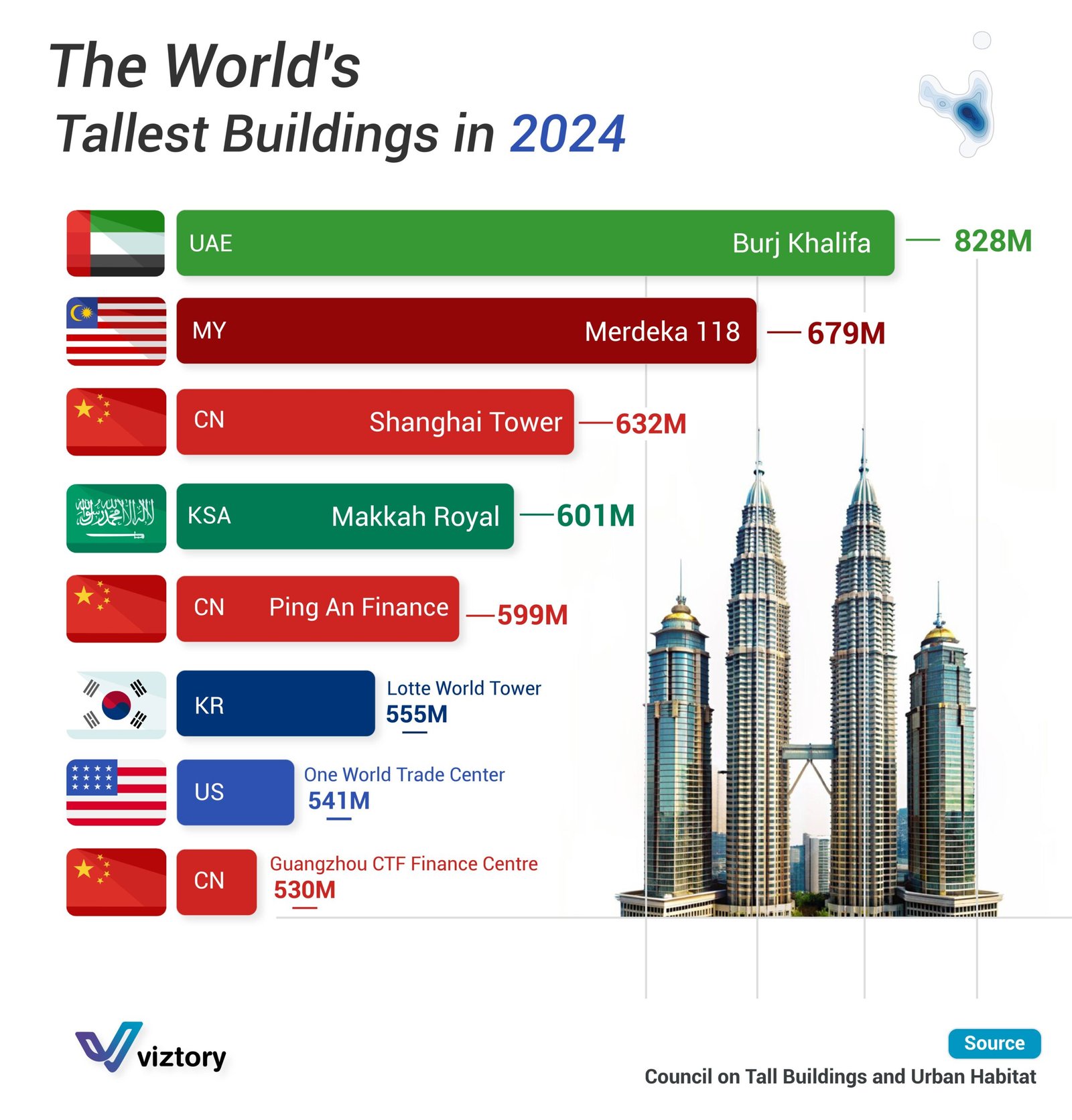The Middle East’s Rise in the Global Skyline: Tallest Buildings in 2024
-
Sep, Thu, 2024
The Middle East’s Rise in the Global Skyline: Tallest Buildings in 2024
The image highlights the world’s tallest buildings in 2024, with the iconic Burj Khalifa in the UAE topping the list at a staggering 828 meters. The presence of the Makkah Royal Clock Tower in Saudi Arabia, standing tall at 601 meters, further solidifies the Middle East’s growing dominance in the architectural and engineering world. This architectural feat signifies not only the region’s modern ambitions but also its historical role as a center for commerce, culture, and innovation.
The Burj Khalifa: A Symbol of Middle Eastern Vision
Standing at 828 meters, the Burj Khalifa in Dubai, UAE, remains the world’s tallest building. Its towering presence is a testament to the Middle East’s rapid economic growth and urbanization, particularly in the Gulf region. The Burj Khalifa is more than just a skyscraper; it symbolizes Dubai’s emergence as a global city, a hub for tourism, commerce, and luxury living.
The construction of the Burj Khalifa has had far-reaching effects on the Middle East’s image. It represents the blending of traditional Middle Eastern culture with futuristic innovation. The success of this project has set a precedent for other ambitious infrastructure projects in the region, demonstrating the Gulf countries’ desire to lead not only in energy production but also in technology, tourism, and real estate.
The Makkah Royal Clock Tower: A Fusion of Tradition and Modernity
The Makkah Royal Clock Tower in Saudi Arabia, towering at 601 meters, holds profound religious and cultural significance in addition to its architectural prestige. Located near the Grand Mosque in Mecca, it serves millions of Muslim pilgrims every year. The tower represents the fusion of tradition with modernity, embodying the Kingdom’s efforts to preserve its rich Islamic heritage while modernizing its infrastructure to accommodate growing populations and global visitors.
Saudi Arabia’s inclusion in the list of the world’s tallest buildings signifies the country’s broader ambitions. The Kingdom’s Vision 2030 plan aims to diversify its economy beyond oil, focusing on sectors such as tourism, entertainment, and real estate. Mega-projects like the Neom City and Red Sea Project are part of this grand vision, showcasing the region’s potential to attract global investors and tourists.
Architectural Pioneering in the Middle East
The Middle East has increasingly become a region associated with groundbreaking architectural and engineering feats. By investing heavily in infrastructure, the region has transformed its urban landscapes, driven by oil wealth and forward-looking economic plans. Cities such as Dubai, Riyadh, and Jeddah have become symbols of what can be achieved with visionary leadership and strategic investment.
One of the most important factors driving these developments is the desire to diversify economies, particularly in the Gulf Cooperation Council (GCC) nations. The reliance on oil revenues has prompted these countries to seek alternative sources of income, including real estate, tourism, and finance. Ambitious architectural projects like the Burj Khalifa and the Makkah Royal Clock Tower are designed to attract tourists, businesses, and investors from around the world, contributing to long-term economic sustainability.
The Middle East’s Future in Global Architecture
The Middle East’s architectural success is not limited to the tallest buildings. Upcoming projects like Jeddah Tower in Saudi Arabia are set to surpass the Burj Khalifa, aiming to become the next tallest building in the world, standing over 1,000 meters. These developments reflect the region’s competitive drive to lead globally in architecture, technology, and economic development.
As the Middle East continues to modernize and build mega-infrastructure projects, its cities are transforming into global powerhouses. The pursuit of architectural excellence also aligns with regional goals of becoming more sustainable, using cutting-edge technology to reduce carbon footprints while maintaining their status as iconic destinations.
Conclusion
The Middle East’s dominance in the global architectural scene, exemplified by the Burj Khalifa and the Makkah Royal Clock Tower, reflects the region’s broader ambitions in economic diversification and cultural leadership. These towering structures are not only symbols of wealth and modernization but also embody the Middle East’s commitment to positioning itself as a global leader in innovation and infrastructure. As we look to the future, it is clear that the region’s skyline will continue to grow, further solidifying its place at the heart of global architectural and economic discourse.

